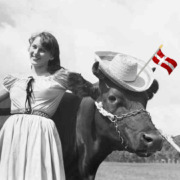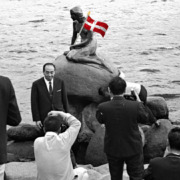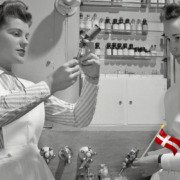Practical tips for moving to Denmark
Denmark is a lovely place to settle down for a while, or even permanently if you are ready to do battle with the immigration authorities. While I’m no expert on Danish visas or immigration law, I can offer a few practical tips for moving to Denmark.
First of all, make sure you bring money. Denmark is an expensive place to live where you will own less stuff, but better stuff.
That said, there’s no need to bring much furniture, in particular if your furniture is nothing special.
You can easily purchase basic pieces from IKEA, either in Denmark or in IKEA’s homeland of Sweden, and there’s also the option of buying gorgeous Danish design furniture inexpensively at local second-hand stores and flea markets.
Clothing and beauty products
Bring lots of casual, warm, and waterproof clothing. You don’t need huge polar jackets – Denmark rarely goes below 0 Fahrenheit/-15 Celsius – but halter tops and suede loafers will see very little service.
When it comes to business clothing, blazers, sweaters, and trousers in subtle colors are usually your best bet. (Danes are not great fans of whimsy or eccentricity when it comes to clothing or jewelry.)
Pack extras of any beauty brands or personal care brands you can’t live without. Items sent from the US (or anywhere else outside the EU) to Denmark require substantial postage plus withering customs and administration fees. Plan on at least $50 per item.
In addition, if there are any over-the-counter medicine brands you find comforting when you are sick – NyQuil, Pepto-Bismol, Sinutab, etc. – bring them along.
Danes don’t do a lot of over-the-counter medicine; their preferred remedy is a nap and a cup of tea. Generic Tylenol and Advil are easy to find in Denmark.
An apartment in Denmark
If you rent an apartment in Denmark, be aware that it will need to be spotless, repainted, and sometimes refloored when you return it. Take time-stamped photos on the day you move in to avoid arguments later.
Many urban apartments do not have bathtubs, only showers. In some cases, you will need to buy your own refrigerator and washer-dryer for a rental apartment.
Europe uses a different electrical current than the US, so leave your blenders, mixers, and hairdryers at home unless you want to constantly use them with a converter, which is a pain and a fire hazard.
Bedding systems are different, too; mattresses are thinner and there are no flat sheets.
Kitchen garbage disposals do not exist in Denmark. Instead, many communities have specific programs to pick up organic waste, which is carefully separated from plastic, metal, paper, and glass.
Air conditioning is unusual in Denmark, because the weather is rarely hot enough to require it. You can always open a window, but the windows have no screens.
Religious services
If you’re a Christian and want to go to services during your time in Denmark, seek out an international church. Danish state churches, which are supported by a voluntary tax, are very quiet and usually poorly attended.
There are very small Jewish and Hindu communities in Denmark, and a large Muslim community. Muslims make up roughly 6% of the Danish population, and there are several new and attractive mosques financed from abroad.
Medical care in Denmark
Anyone with legal residence in Denmark is entitled to tax-financed Danish medical care. You will be asked to choose a doctor shortly after you arrive, selecting from a list of general practitioners with offices close to your home address.
Ask your colleagues for recommendations; alternately, you may get some good tips from the many Facebook groups for internationals living in Denmark.
Eyeglasses, dentistry for adults, and some types of mental health care are not covered by the public system, so you’ll have to pay for those services out of pocket if you need them.
Annual physicals are uncommon, and testing is less extensive. Mammograms start at age 50, for example, instead of age 40 as in much of the US.
Danish physicians shy away from prescription medicine, particularly antibiotics, painkillers, and sleep medication. (Even melatonin is technically illegal in Denmark.)
Medical care for specific cases
In addition, some people of Asian or African descent living in Denmark have told me that ethnic Danish doctors aren’t always familiar with medical conditions that are specific to people of color, such as sickle cell anemia.
Finding a doctor who shares your ethnicity isn’t always possible, particularly outside of the big cities.
You may need to get aggressive about your care, insisting on a second opinion, if you suspect that your doctor isn’t giving you the right advice.
This may also be true if you have a medical condition and are accustomed to getting a specific medication at home.
Not all pharmaceuticals are available in Denmark, and ordering your pharma online from outside the country is illegal.
If you’re caught, you can get a fine and a police record that will affect your ability to achieve permanent residency or citizenship.
Entertainment
Most English-language movies and TV shows in Denmark are presented in the original version with Danish-language subtitles, so you’ll be able to watch many of your favorite shows on the local version of Netflix or HBO Nordic.
The selection isn’t as extensive as it might be at home, however, and some shows are only available a few weeks or months after they premiere elsewhere. (You can use a VPN to try to get around this.)
Some services, like Amazon Prime, use geo-blocking so that even shows you have downloaded in the US cannot be viewed in Denmark. Others will let you purchase and download films from your US account even though you are in Denmark.
Remember that DVDs manufactured for the US market may not play on Danish DVD players, which are designed for a different copyright region.
If you like board games, consider bringing along some versions with English-language boards and English-language rules.
Cooking and kitchenware
Danes love their kitchens, so you won’t have much trouble replacing any kitchenware you leave behind. That said, don’t forget to pack American measuring spoons and cups to match your American recipes, along with any unusual ingredients you might require.
Denmark does have Asian and African markets that carry a variety of spices, but if you need ingredients that are specifically North American or Latin American – canned pumpkin, for example, or specific chilis – you may be out of luck.
A few US foods that are also popular with Danes, such as French’s hot dog mustard, are available in the American “ethnic” section of supermarkets, which is sometimes set off with tiny American flags.
[icon name=”facebook-square” class=”fa-3x”] [icon name=”twitter-square” class=”fa-3x”][icon name=”instagram” class=”fa-3x”]
This is an excerpt from Kay Xander Mellish’s new book, Working with Danes: Tips for Americans/Working with Americans: Tips for Danes. You can see more excerpts by following Kay on LinkedIn.
Tips for moving to Denmark for Americans.





